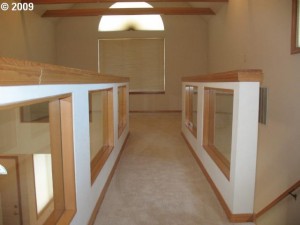 Both in my personal experience, as I see transactions through escrow to closing, and in the continuing education classes I have lately been taking, I am seeing some very strong changes in lending guidelines. These changes are coming from the Federal Government as part of addressing the mortgage crisis that our country has recently endured. I think that it is important, no matter where you fit into the real estate picture, to understand these changes and adapt your expectations and behavior to accommodate them. The days of having a credit score and a pulse to get a mortgage are over. The days of a 30 day escrow are going to be rare, and here is why:
Both in my personal experience, as I see transactions through escrow to closing, and in the continuing education classes I have lately been taking, I am seeing some very strong changes in lending guidelines. These changes are coming from the Federal Government as part of addressing the mortgage crisis that our country has recently endured. I think that it is important, no matter where you fit into the real estate picture, to understand these changes and adapt your expectations and behavior to accommodate them. The days of having a credit score and a pulse to get a mortgage are over. The days of a 30 day escrow are going to be rare, and here is why:
The first big change in lending practices happened June 1 of 2009 with the implementation of MIDA, the Mortgage Improvement Disclosure Act. This Federal law requires that every time a borrower receives a Good Faith Estimate (the paperwork that lays out estimated costs to obtain a mortgage) the borrower must be given a 7-day disclosure period in which to become knowledgeable of the terms of the mortgage and either accept those terms or shop for a better deal. It makes sense. Buyers are faced with a very large and important financial decision. They need to understand what they are doing and approve of the loan product that they will be obtaining. It gives a borrower some breathing room in the process so that they are not pressured into a loan that they will later on regret. Where it gets dicey is if any changes happen to the loan while it’s in escrow. Every time a change occurs that affects the APR by more than 1/8th, a new Good Faith Estimate must be issued and a new 7 day disclosure period must pass. So let’s say that a buyer does not lock their interest rate until just prior to closing and the rate changes. The lender can not allow closing of the sale until that 7-day disclosure period has passed. A more common variable would be if the buyer has a home inspection and chooses to have the seller pay some of his closing costs in lieu of repairs. When the seller pays the buyers closing costs it changes the buyers Good Faith Estimate and a new 7-day disclosure period must pass. This is not going to be a big deal if all parties go into the escrow period understanding how important it is to allow time for disclosure periods and being aware of what can trigger them. I think it is more important than ever to lock in your interest rate early in the escrow period so that you don’t get thrown for a loop at the last minute.
The other changes that are occurring are a result of the Real Estate Settlement Procedures Act, which goes into effect on January 1, 2010.
The Federal Government has now defined what constitutes a pre-approval on a loan application. In the past a buyer would make a loan application prior to making an offer on a house. That buyer could then provide a letter of pre-approval from a lender showing that they are approved as a borrower but subject to finding a house. The Federal Government is now saying that no loan approvals can be given without an address attached to the approval. So a borrower can get pre-qualified for a loan (credit report pulled and debt to income factored to estimate that they can be approved in the future) but they can not get pre-approved.
The next big change is the change to required Federal forms for both the Good Faith Estimates and for final HUD Settlement Statements. I have seen the new Good Faith Estimate forms and I like them. They look more like a worksheet. And they have very clear sections where the lender must put in total sum numbers for “all other settlement charges”. So many lenders call their fees by different names. So a borrower, when comparing loan programs, would have to compare a variety of charges that, because they had different names, were confusing. By requiring a lump sum figure it doesn’t matter the names of the charges or even the quantity. What matters is the bottom line and this new form makes it easy for a borrower to see the sum total and compare sum totals between lenders. Once the Good Faith Estimate is given the lender is required to allow the borrower 10 days to shop other loan programs. The Good Faith Estimate has blank columns that line up next to the estimate given that allows a borrower to write in the fees they find with other lenders. The finished form will clearly show the borrower the various costs for various programs. I think it is an improvement.
Another change is that there is a 3-day disclosure program for the appraisal. This means that the borrower must be given a copy of the completed appraisal at least 3 days prior to closing so that they can look it over and understand it. The days of the appraisal being given to the borrower when they sign the loan papers, or perhaps even having to request that it be mailed to them, are over. Again, I think this is an improvement. Not only do buyers deserve to see the documentation of value, it just seems like professional courtesy to take this extra step.
Finally, there is what is called the 10% Tolerance. At closing the numbers given in the Good Faith Estimate are lined up against the actual settlement charges on the HUD Settlement Statement. If there is a difference in the charges of 10% or greater, the lender must absorb the difference. This can be done by reducing the lender charges at closing or by reimbursing the borrower within 30 days of closing. Seriously, this is a big IMPROVEMENT for borrowers.
All of these changes are going to mean that if there is a mortgage involved, it will take a little longer to close a transaction. Realistically, you should expect escrow to last about 45 days. And as much as the buyer and seller might be willing to close sooner, the process can not be rushed. These are Federal guidelines that preclude the terms of the written contract.
I have got to share one more word of advice. If you are buying a home and you have made an offer that has been accepted, do not purchase ANYTHING using credit. Lenders are now pulling credit reports just prior to funding the loan. If your credit score has changed or your credit card balances have increased, it can kick your new mortgage right back into underwriting. This recently happened to a buyer of one of my listings. Not only did he have to pay off the new credit card charges, but we had to wait an entire week for the lower credit card balances to be reflected on a new credit report from one of the National credit reporting bureaus. It delayed closing on the purchase for 2 weeks. So much for moving in by Thanksgiving……
So be aware, be patient, and be realistic about what to expect. There is a new lending environment, but for the most part it does benefit the borrower. Change can be a good thing.
If you would like a pdf of the Real Estate Settlement Procedures Act, click here.

 It isn’t often that we shine the spotlight on any particular property, but when we heard that the new luxury town homes on Sixth St in sought-after First Addition had just lowered their prices by $100,000 each to $599,900., Dianne and I just had to run over there and take a look.
It isn’t often that we shine the spotlight on any particular property, but when we heard that the new luxury town homes on Sixth St in sought-after First Addition had just lowered their prices by $100,000 each to $599,900., Dianne and I just had to run over there and take a look. ML# if you want to get a preview is 9057549. Each has 2258 SF, 3 bedrooms, 3 & 1/2 baths, 2 levels with additional full finished basements, and probably just everything you’ve been looking for.
ML# if you want to get a preview is 9057549. Each has 2258 SF, 3 bedrooms, 3 & 1/2 baths, 2 levels with additional full finished basements, and probably just everything you’ve been looking for. cabinets also boasts additional built-ins and smart features like a pull-down bar. The dark french doors to the front porch area off the dining room are a rich contrast, and the white wainscoting throughout adds that crisp old-world cottage feel. The 2-car detached garage out back with private courtyard to the house is an added bonus in First Addition, and from there you enter the great room compete with gas fireplace and more built-ins.
cabinets also boasts additional built-ins and smart features like a pull-down bar. The dark french doors to the front porch area off the dining room are a rich contrast, and the white wainscoting throughout adds that crisp old-world cottage feel. The 2-car detached garage out back with private courtyard to the house is an added bonus in First Addition, and from there you enter the great room compete with gas fireplace and more built-ins. Downstairs you find another gas fireplace and generous media room as well as another bedroom & bathroom w/an additional laundry area for guests or your reclusive teenager. Upstairs is the master bedroom & bath showing off glorious travertine w/onyx, a clawfoot tub & separate shower as well as an additional bathroom w/soaker tub & yet another bedroom. Walk-in closets of course, and the main laundry near the upstairs bedrooms check those final “must-haves” off the list.
Downstairs you find another gas fireplace and generous media room as well as another bedroom & bathroom w/an additional laundry area for guests or your reclusive teenager. Upstairs is the master bedroom & bath showing off glorious travertine w/onyx, a clawfoot tub & separate shower as well as an additional bathroom w/soaker tub & yet another bedroom. Walk-in closets of course, and the main laundry near the upstairs bedrooms check those final “must-haves” off the list. Overall, these are just so unique & have that easy-living feel that goes hand in hand with the First Addition lifestyle… you know, walking to all the services, trendy shops and restaurants, not to mention Millenium Park Plaza for a view of the lake & all the festive local activities like Farmer’s Market, open air Movie Nights, Holiday Tree-Lighting festivities and on & on. First Addition is just a strolling kinda place; a small-town feel with all the amenities. Cottage Living
Overall, these are just so unique & have that easy-living feel that goes hand in hand with the First Addition lifestyle… you know, walking to all the services, trendy shops and restaurants, not to mention Millenium Park Plaza for a view of the lake & all the festive local activities like Farmer’s Market, open air Movie Nights, Holiday Tree-Lighting festivities and on & on. First Addition is just a strolling kinda place; a small-town feel with all the amenities. Cottage Living  magazine named First Addition as one of the ten best cottage communities in the country. American Planning Association name it one of the top 10 neighborhoods in America. The accolades go on & on.
magazine named First Addition as one of the ten best cottage communities in the country. American Planning Association name it one of the top 10 neighborhoods in America. The accolades go on & on. Come on down & take a look. Bring a Realtor as there has been a lot of interest. They will be held open both Saturday & Sunday from 1 – 4.
Come on down & take a look. Bring a Realtor as there has been a lot of interest. They will be held open both Saturday & Sunday from 1 – 4. The tax year runs from July 1st to June 30th, but you receive your tax statement in October for payment on November 15th. No wonder people are confused! Not only does the tax year not correspond with the calendar year, but you get your statement at a completely odd time as well. (Is this some sort of a conspiracy?) So when you pay your taxes in November you are paying in arrears back to July 1 and ahead to June 30. You can pay your taxes in one lump sum and receive a discount, or you can pay it in thirds with the final third due in May.
The tax year runs from July 1st to June 30th, but you receive your tax statement in October for payment on November 15th. No wonder people are confused! Not only does the tax year not correspond with the calendar year, but you get your statement at a completely odd time as well. (Is this some sort of a conspiracy?) So when you pay your taxes in November you are paying in arrears back to July 1 and ahead to June 30. You can pay your taxes in one lump sum and receive a discount, or you can pay it in thirds with the final third due in May. Yes, your property taxes will probably go up this year even though your house value has likely gone down. Right now, this is the most confusing issue about property taxes and is getting a lot of play in the media. This is happening because of the restriction that was placed onto annual tax increases in the mid-1990’s. At that time house values were going up quickly and property taxes were going up at the same pace. This was creating financial hardship because people’s incomes were not keeping pace. A ballot measure was passed that restricted annual tax increases to not more than 3% per year plus any bond measures passed through public vote. Bond measures are those ballot measures that supply funding to build libraries, schools, zoos, etc. Lots of bond measures have been passed in the last 15 years, including an $80,000,000 bond measure that re-built the two High Schools here in Lake Oswego.
Yes, your property taxes will probably go up this year even though your house value has likely gone down. Right now, this is the most confusing issue about property taxes and is getting a lot of play in the media. This is happening because of the restriction that was placed onto annual tax increases in the mid-1990’s. At that time house values were going up quickly and property taxes were going up at the same pace. This was creating financial hardship because people’s incomes were not keeping pace. A ballot measure was passed that restricted annual tax increases to not more than 3% per year plus any bond measures passed through public vote. Bond measures are those ballot measures that supply funding to build libraries, schools, zoos, etc. Lots of bond measures have been passed in the last 15 years, including an $80,000,000 bond measure that re-built the two High Schools here in Lake Oswego. 113 Kingsgate Rd Priced at $275,000, this house has 3 bedrooms, 2 full baths, and a 2-car attached garage. It’s located on the South slope of Mountain Park, so it is really convenient to the Kruse Way corridor, I-5, and Hwy 217. Oak Creek Elementary School is just down the street, and PCC Sylvania Campus is close by. While the lot is smaller (about 4000 square feet) it is extremely private. So you can have the easy care of a small yard, but the benefit of privacy. That’s a tough combination to find. Probably the most striking feature of the house (besides the master on the main, the hardwood floors, the wet bar, and the gas fireplace) is the 2-story vaulted ceiling. Architecturally, this house is wonderful and unique. This is not a cookie-cutter house. When you walk in the door, you will say “Wow”.
113 Kingsgate Rd Priced at $275,000, this house has 3 bedrooms, 2 full baths, and a 2-car attached garage. It’s located on the South slope of Mountain Park, so it is really convenient to the Kruse Way corridor, I-5, and Hwy 217. Oak Creek Elementary School is just down the street, and PCC Sylvania Campus is close by. While the lot is smaller (about 4000 square feet) it is extremely private. So you can have the easy care of a small yard, but the benefit of privacy. That’s a tough combination to find. Probably the most striking feature of the house (besides the master on the main, the hardwood floors, the wet bar, and the gas fireplace) is the 2-story vaulted ceiling. Architecturally, this house is wonderful and unique. This is not a cookie-cutter house. When you walk in the door, you will say “Wow”.
 4447 Golden Lane Priced at $229,000, this is an end-unit condo with 2 bedrooms, 2 full baths, and a 2-car, attached garage. It has expansive South facing windows so that the interior is light and bright even on those short, winter days. The kitchen has new granite counters and there are new laminate floors. Like the property above, this home is on the South slope of Mountain Park. Living in this location, you benefit from the Mountain Park recreational facilities. There are 15 miles of walking trails, tennis courts, a swimming pool and a weight room. Living in a condominium means that you don’t have to take care of a yard or worry about maintenance of the exterior. It’s ideal for someone with a busy job or who likes to travel a lot.
4447 Golden Lane Priced at $229,000, this is an end-unit condo with 2 bedrooms, 2 full baths, and a 2-car, attached garage. It has expansive South facing windows so that the interior is light and bright even on those short, winter days. The kitchen has new granite counters and there are new laminate floors. Like the property above, this home is on the South slope of Mountain Park. Living in this location, you benefit from the Mountain Park recreational facilities. There are 15 miles of walking trails, tennis courts, a swimming pool and a weight room. Living in a condominium means that you don’t have to take care of a yard or worry about maintenance of the exterior. It’s ideal for someone with a busy job or who likes to travel a lot. 15139 Tree Rd Priced at $298,900, this house has 3 bedrooms , 2 full baths, and a 2-car garage. It’s in a great location at the end of a dead-end street. There are hardwood floors throughout. It has a formal living room, but what I like is the openness of the greatroom for the kitchen, dining room, and family room. There is a masonry fireplace made with used bricks that is warm and inviting. I like to point out to anyone buying a one level home that the demand for these homes will only increase. As the population ages, the need for homes that appeal to older people is going to get bigger. So I do believe that one-level homes make great investments.
15139 Tree Rd Priced at $298,900, this house has 3 bedrooms , 2 full baths, and a 2-car garage. It’s in a great location at the end of a dead-end street. There are hardwood floors throughout. It has a formal living room, but what I like is the openness of the greatroom for the kitchen, dining room, and family room. There is a masonry fireplace made with used bricks that is warm and inviting. I like to point out to anyone buying a one level home that the demand for these homes will only increase. As the population ages, the need for homes that appeal to older people is going to get bigger. So I do believe that one-level homes make great investments.
 I think what is striking about all of these houses is what good condition they are all in. Under $300,000 in Lake Oswego is the lower end of the pricing spectrum. You would normally think that this would also mean that you have to compromise by buying a house that perhaps needs some updating or some work to improve it. That is not the case here. You can buy not only an affordable home, but a home in great condition. Add to that the fact that you can then get an $8000 tax credit from the Federal government and you are talking a perfect storm of opportunity.
I think what is striking about all of these houses is what good condition they are all in. Under $300,000 in Lake Oswego is the lower end of the pricing spectrum. You would normally think that this would also mean that you have to compromise by buying a house that perhaps needs some updating or some work to improve it. That is not the case here. You can buy not only an affordable home, but a home in great condition. Add to that the fact that you can then get an $8000 tax credit from the Federal government and you are talking a perfect storm of opportunity. In particular I want to point out a progressive open house tour being held in Southwood Park. 5 homes are being held open within just a couple of blocks of each other, including my listing at 13638 SW 62nd. Remember that this neighborhood is in unincorporated Clackamas County (which means low taxes), but has Lake Oswego Schools (great for kids and re-sale values). My listing was price reduced this last week from $319,900 to $299,900. That is for a house with 4 bedrooms, 3 full baths, two family rooms, and a 21 x 11 utility room. It needs some cosmetic updating, but has a 50 year metal roof, new windows, and new paint inside and out. If you visit all 5 houses on the tour, your will receive a $5 Starbuck’s gift card. Watch for hellium balloons and lots of open house signs. You’ll find my signs on Lesser Dr to follow them in to the property.
In particular I want to point out a progressive open house tour being held in Southwood Park. 5 homes are being held open within just a couple of blocks of each other, including my listing at 13638 SW 62nd. Remember that this neighborhood is in unincorporated Clackamas County (which means low taxes), but has Lake Oswego Schools (great for kids and re-sale values). My listing was price reduced this last week from $319,900 to $299,900. That is for a house with 4 bedrooms, 3 full baths, two family rooms, and a 21 x 11 utility room. It needs some cosmetic updating, but has a 50 year metal roof, new windows, and new paint inside and out. If you visit all 5 houses on the tour, your will receive a $5 Starbuck’s gift card. Watch for hellium balloons and lots of open house signs. You’ll find my signs on Lesser Dr to follow them in to the property. As with our entire society, the real estate community is rapidly changing due to the expanding availability of computer technology and the Internet. I have found myself musing on this subject because of a telephone call I got yesterday. A gentleman wanted information about a house that I have listed for sale. As I always do when I speak to someone about real estate, I asked him if he was already working with a Realtor. Not that it will make any difference in my answering of his questions, I just want to make sure that he has adequate help and I also don’t want to step onto the toes of any other Realtors. His response to me was that he had 3 different agents helping him, but that he didn’t think any of them were really working for him. This was because all 3 had set up e-mail programs that sent him listing information, but that none of them made the effort to speak to him in person. Hmmmm……
As with our entire society, the real estate community is rapidly changing due to the expanding availability of computer technology and the Internet. I have found myself musing on this subject because of a telephone call I got yesterday. A gentleman wanted information about a house that I have listed for sale. As I always do when I speak to someone about real estate, I asked him if he was already working with a Realtor. Not that it will make any difference in my answering of his questions, I just want to make sure that he has adequate help and I also don’t want to step onto the toes of any other Realtors. His response to me was that he had 3 different agents helping him, but that he didn’t think any of them were really working for him. This was because all 3 had set up e-mail programs that sent him listing information, but that none of them made the effort to speak to him in person. Hmmmm…… You know, Dianne and I talk about this a lot, but I think it bears mentioning at this crucial moment when we have so little time before the $8,000. tax credit incentive has timed out (it expires on December 1st… that means that any transaction where there is the intention of taking advantage of this needs to close by November 30th). What is it that Dianne and I harp on so often that comes into play here? I’ll tell you- it’s “affordable homes in Lake Oswego”. You know, the kind that many first time home buyers would be interested in… homes under, let’s say, $350,000… Homes in a great school district, in a community where all types of individuals tend to participate and make their voices heard, where there are farmers markets, art festivals, music in the park, great shops & services, where families are valued and supported with programs and activities specific to those needs… and on & on. Here is a link to the city’s website if you’d like to find out more:
You know, Dianne and I talk about this a lot, but I think it bears mentioning at this crucial moment when we have so little time before the $8,000. tax credit incentive has timed out (it expires on December 1st… that means that any transaction where there is the intention of taking advantage of this needs to close by November 30th). What is it that Dianne and I harp on so often that comes into play here? I’ll tell you- it’s “affordable homes in Lake Oswego”. You know, the kind that many first time home buyers would be interested in… homes under, let’s say, $350,000… Homes in a great school district, in a community where all types of individuals tend to participate and make their voices heard, where there are farmers markets, art festivals, music in the park, great shops & services, where families are valued and supported with programs and activities specific to those needs… and on & on. Here is a link to the city’s website if you’d like to find out more:  So…. you’re moving, or getting ready to sell, or in the middle of a home inspection on either end of the transaction. One of the myriad things that may cross your path is the issue of insulation. Some homes have it, some don’t. Some have it in the walls but nowhere else, some have it in the floors and ceilings. A lot depends on the era of the home and whether and how much updating has been done. If you are selling your home and your home has insulation, say underneath, that has been damaged (squirrels, etc), you may be asked to repair or replace it. If you have an older home with blown-in insulation in the attic, you may want to know what the material consists of. If you are buying a home without insulation in the walls, you may be wanting to add some after the purchase is complete. Here are some hopefully helpful tidbits on insulation:
So…. you’re moving, or getting ready to sell, or in the middle of a home inspection on either end of the transaction. One of the myriad things that may cross your path is the issue of insulation. Some homes have it, some don’t. Some have it in the walls but nowhere else, some have it in the floors and ceilings. A lot depends on the era of the home and whether and how much updating has been done. If you are selling your home and your home has insulation, say underneath, that has been damaged (squirrels, etc), you may be asked to repair or replace it. If you have an older home with blown-in insulation in the attic, you may want to know what the material consists of. If you are buying a home without insulation in the walls, you may be wanting to add some after the purchase is complete. Here are some hopefully helpful tidbits on insulation: